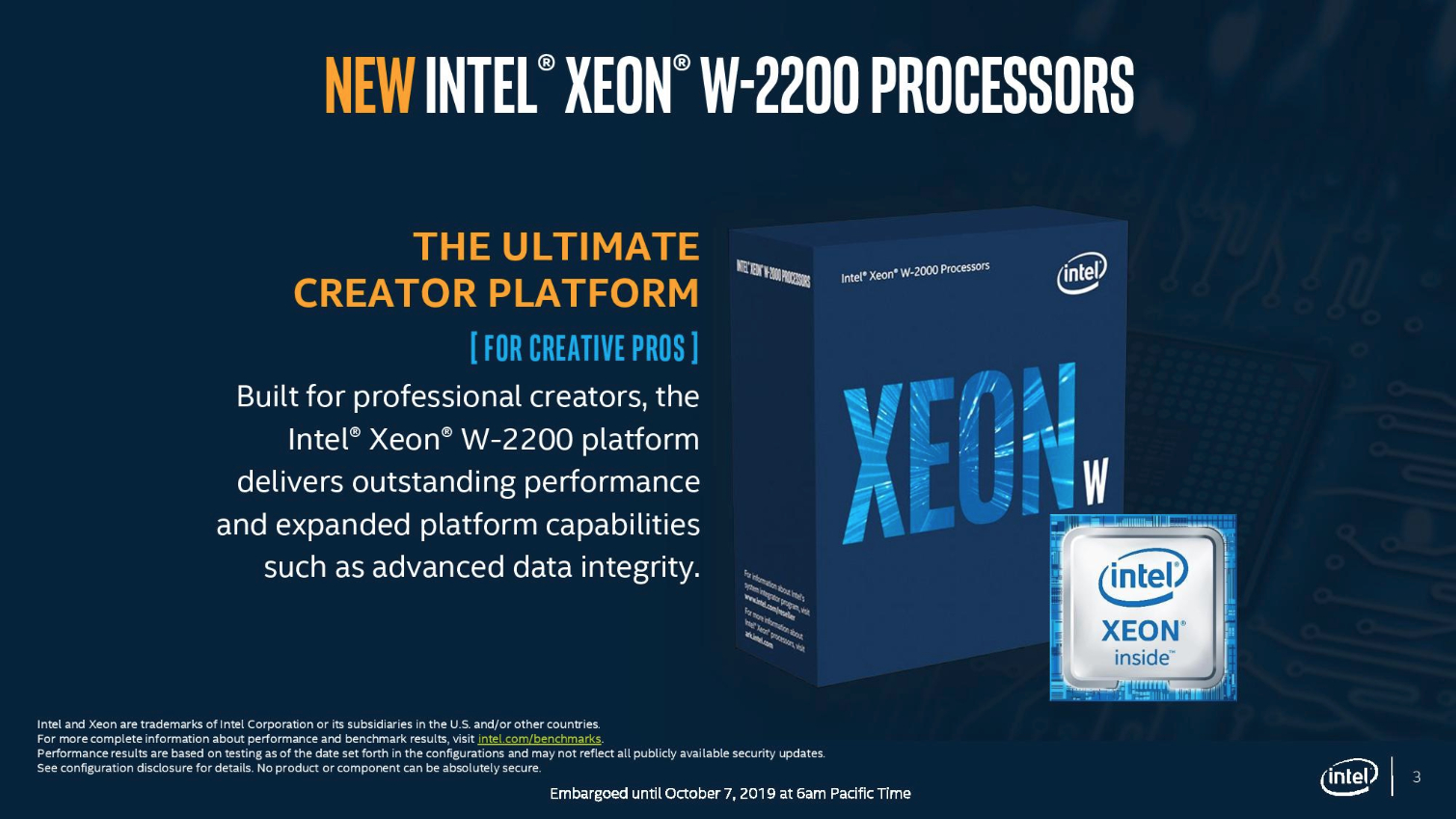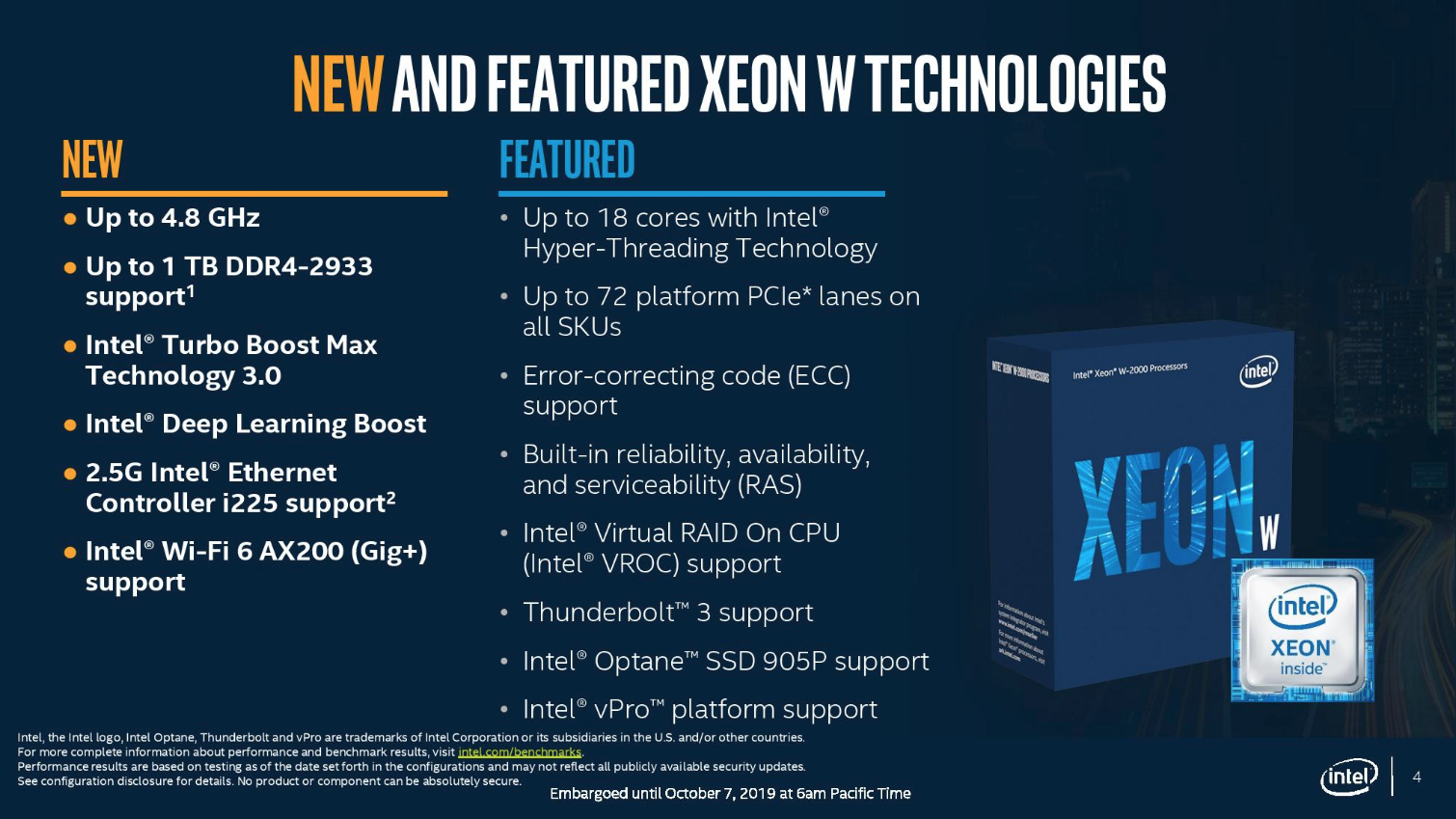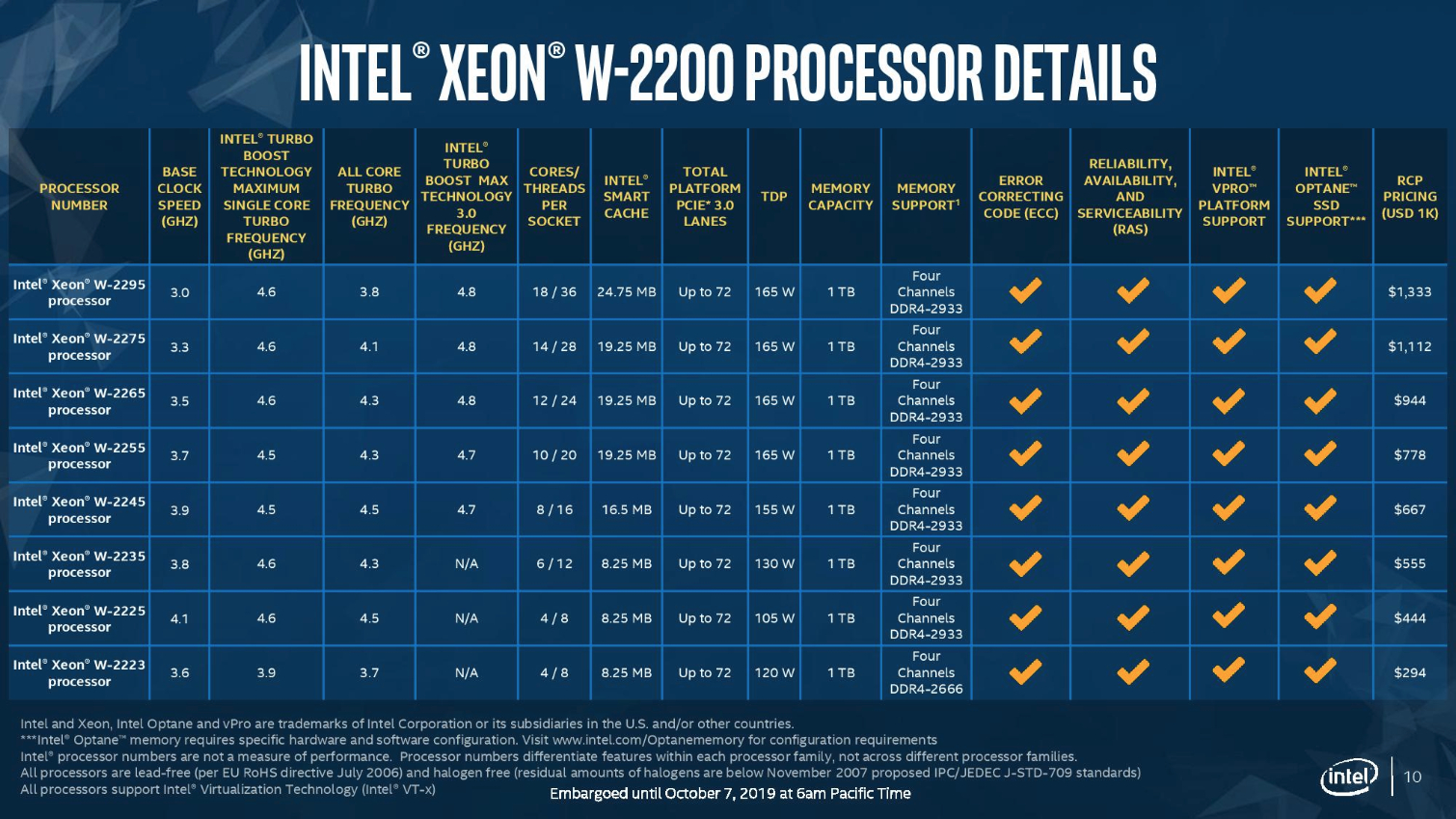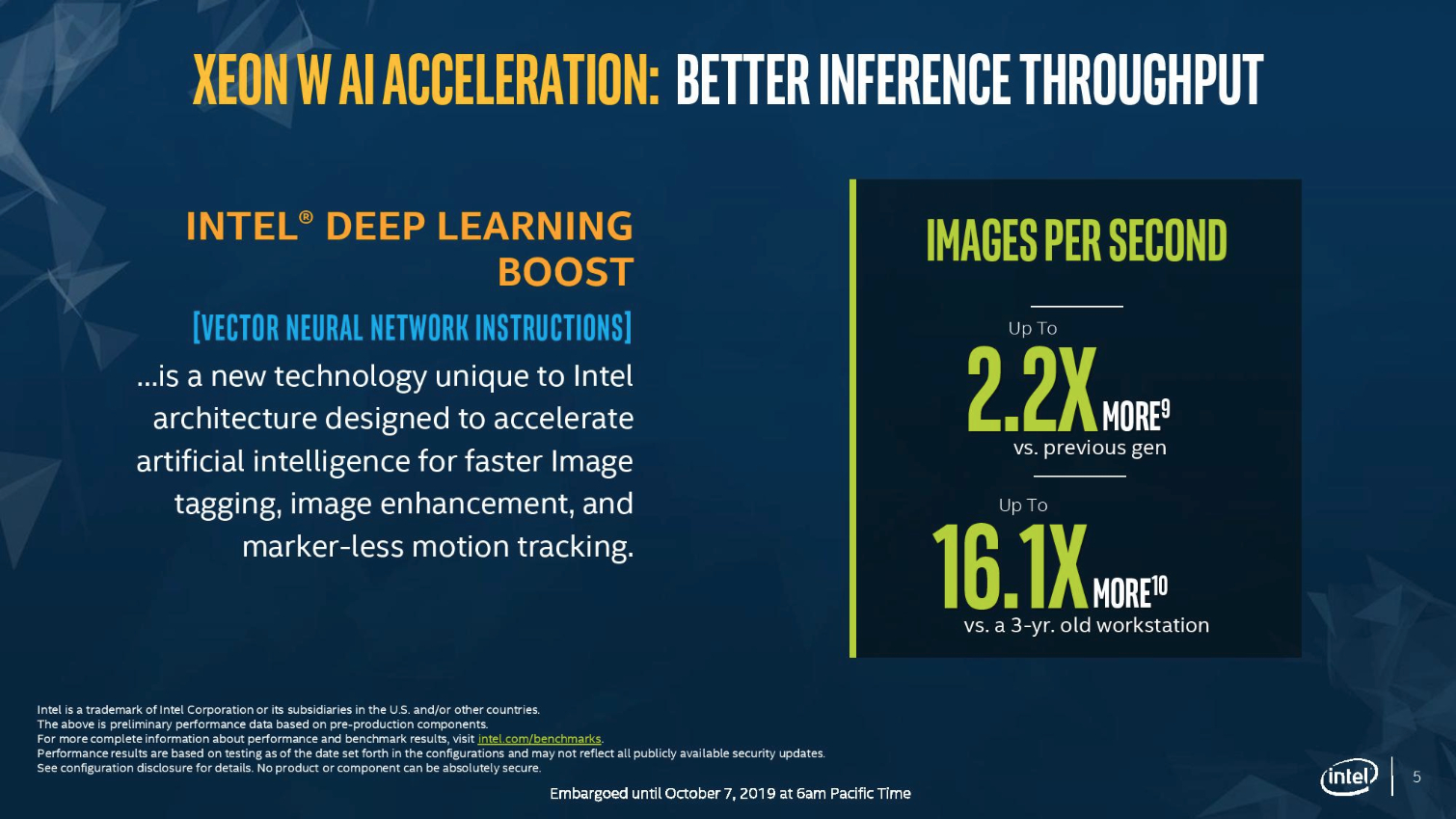Intel Announces Cascade Lake Xeon W-2200 Series, Slashes Pricing up to 48 Percent
Intel announced its new Xeon W-2200 Series processors today to bring its Cascade Lake lineup to the workstation, and much like last week's announcement of the Cascade Lake-X processors, these chips come with a healthy gen-on-gen price cut of up to ~48%, though though the company still commands eye-watering prices for the lower core-count models.
The price cuts are an expected move, largely because these chips are nearly identical to their X-Series counterparts while adding in support for ECC memory (a must for professionals), Intel vPro, and other RAS features. Unlike Intel's W-3200 series counterparts that drop into a server socket, these chips use the same LGA2066 socket as their predecessors.



The chips make a significant step forward on many fronts: Intel doubled memory capacity support to 1TB and increased memory from DDR4-2666 to DDR4-2933. Intel also enables support for Wi-Fi 6 and 2.5 GbE through secondary modules.
Intel also added Turbo Boost Max 3.0 to most of its new W-2200 models, whereas the previous-gen only supported Turbo Boost 2.0. As the company also announced with its X-series models, Turbo Boost Max 3.0 now targets four cores with lightly-threaded workloads, as opposed to two with the previous-gen models. However, the frequency for the second two fastest cores drop 100 MHz from the listed Turbo Boost Max 3.0 frequency.
Intel has also brought support for DL Boost, Intel’s new AI-focused instructions that double or triple the performance of FP16 or INT8 AVX-512 vector code. The feature enables radical performance increases to image enhancement, image tagging, video analysis, and voice recognition programs.
Intel Cascade Lake Xeon W Specifications
| Row 0 - Cell 0 | Cores / Threads | Base / Boost (TB 3.0) | L3 Cache (MB) | DRAM | TDP | RCP | Price-per-core |
| W-2295 | 18 / 36 | 3.0 / 4.8 | 24.75 | Quad 2933 | 165W | $1,333 | $74.06 |
| W-2195 | 18 / 36 | 2.3 / 4.3 | 24.75 | Quad 2666 | 140W | $2,553 | $141.83 |
| W-2275 | 14 / 28 | 3.3 / 4.8 | 19.25 | Quad 2933 | 165W | $1,112 | $79.43 |
| W-2175 | 14 / 28 | 2.5 / 4.3 | 19.25 | Quad 2666 | 140W | $1,974 | $141 |
| W-2265 | 12 / 24 | 3.5 / 4.8 | 19.25 | Quad DDR4-2933 | 165W | $944 | $78.67 |
| W-2255 | 10 / 20 | 3.7 / 4.7 | 19.25 | Quad DDR4-2933 | 165W | $778 | $77.80 |
| W-2155 | 10 / 20 | 3.3 / 4.5 | 13.75 | Quad 2666 | 140W | $1,440 | $144 |
| W-2245 | 8 / 16 | 3.9 / 4.7 | 16.5 | Quad DDR4-2933 | 155W | $667 | $83.38 |
| W-2145 | 8 / 16 | 3.7 / 4.5 | 11 | Quad 2666 | 140W | $1,113 | $139.13 |
| W-2235 | 6 / 12 | 3.8 / 4.6 (TB 2.0) | 8.25 | Quad DDR4-2933 | 130W | $555 | $92.50 |
| W-2135 | 6 / 12 | 3.7 / 4.5 | 8.25 | Quad 2666 | 140W | $835 | $92.50 |
| W-2225 | 4 / 8 | 4.1 / 4.6 (TB 2.0) | 8.25 | Quad DDR4-2933 | 105W | $444 | $139.17 |
| W-2125 | 4 / 8 | 4.0 / 4.5 | 8.25 | Quad 2666 | 120W | $444 | $139.17 |
| W-2223 | 4 / 8 | 3.6 / 3.9 (TB 2.0) | 8.25 | Quad DDR4-2933 | 120W | $294 | $73.50 |
| W-2123 | 4 / 8 | 3.6 / 3.9 | 8.25 | Quad 2666 | 120W | $244 | $73.50 |
As before, these chips are based on the Skylake microarchitecture and Intel's 14nm process, though the company isn't specifying which "+" revision. The processors support 48 native PCIe 3.0 lanes and 72 lanes from the chipset.
As you can see, the W-2200 series gets a big reduction in price per core, which in turn equates to more performance for your dollar. These chips are under assault from AMD's Threadripper lineup, even though those chips don't support many of the same workstation-class features. That's expected to change soon. AMD has a full cadre of new Threadripper chips coming, now purportedly split into both workstation and prosumer models and platforms, much like Intel's Xeon W and Cascade Lake-X lineups. That opens up a new angle of attack on Xeon W.
Get Tom's Hardware's best news and in-depth reviews, straight to your inbox.
Even with the price reductions, you still pay a hefty premium for the workstation-class features with the W-2200 Series models compared to the consumer models. Intel still commands $444 and $294 for the quad-core models at the bottom of the range, likely because there are no competing chips from AMD at these lower core counts. Intel also added a 12-core model to the new lineup, and we notice a bump in L3 cache capacity for the 8- and 10-core models. Intel also trimmed Turbo Boost Max 3.0 support from the four- and six-core models.
We see a marked increase in TDP ratings for chips with similar core counts, which is a logical impact from the heightened base clock speeds, with improvements stretching up to 800 MHz on some models.
Intel Cascade Lake Xeon W Performance



Intel also shared performance data derived from its own internal tests, but take it with a grain of salt. The reason for that is simple: For the three-year-old systems, Intel put its high-end 18C/36T Xeon W-2295 up against the 8-core E5-1680 v4, which obviously will lead to massive performance gains. We're sure the reasoning here is to compare to the highest-end processor available from Intel three years ago, but pitting two eight-core models against each other would be more representative of like-for-like performance gains.
Intel provided gen-on-gen performance improvement data, and comparisons against three-year-old systems to reflect the faster update cadence in the workstation market. Intel's claims include up to 2.2x and 16.1x improvements in inference, respectively, which comes as a byproduct of DL Boost support. Gains are a bit more muted with standard workloads, though the 97% increase in 4K video rendering compared to a three-year-old system stands out. That's not hard when you're putting an 18 core chip up against an eight-core model. We included the test notes in the album above so you can scrutinize the test systems.
Intel Cascade Lake Xeon W Release Date
The new processors will be available in November 2019, and as we see with the X-Series models, we expect a lineup of refreshed C422 chipset-based motherboards to also come to market.

Paul Alcorn is the Editor-in-Chief for Tom's Hardware US. He also writes news and reviews on CPUs, storage, and enterprise hardware.

